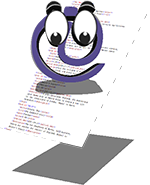You answer your email, check the traffic, and thumb through your friends' latest baby pictures.
With your smartphone in hand, you’re connected, productive, empowered. You feel like yourself.
And when you're away from your phone, you’re just not yourself at all.
This emotional bond that many share with the technologies they use is what fascinates Michelle Carter, an assistant professor at the University of Washington Information School. The extent to which a person's sense of self is tied to a piece of information technology is what she calls an "IT identity."
"We have all of the ways we describe ourselves," Carter said. "An identity is the answer to the question, 'Who am I?' An IT identity is the answer to the question, ‘Who am I in relation to this technology?' "
When you're on the grid, whether it's at a desktop computer, on an iPad, or using an app such as Facebook across different devices, Carter says, your connection can give rise to one or many IT identities -- a view of yourself that's intertwined with the technologies you’re using.
"A lot of it comes down to how embedded a technology is across people's social lives," Carter said. "The more that you enact it across work or at home, the more likely it is that you're aware that this is an important part of who you are."
Carter's concept of IT identity will be published in an upcoming issue of the prestigious journal MIS Quarterly. "Me, My Self, and I(T): Conceptualizing Information Technology Identity and its Implications," written by Carter and Clemson University professor Varun Grover, looks at what it means when a device, an application environment, or an app is seen as integral to what makes a person.
A different self
Carter began developing the theory while working on her Ph.D. at Clemson in 2010. In a study, she and colleagues took students’ phones away for 24 hours. Many of the students found it excruciating. On a bustling college campus, some just went to bed early because they wanted the experience to be over.
But the thing that struck Carter was the feelings the devices engendered in students.
"They talked about feeling pumped up and energized with the phone, and more of who they were," Carter said.
The idea that it was more than a dependency, but an expanded sense of one’s self, was the origin of a new theory that Carter continued to develop after joining the iSchool faculty.
It’s a theory with practical concerns. For technology companies, it means they must consider consumers’ emotional responses to product updates. Too much change can disrupt a person’s IT identity; not enough change can make things stale to the point where the consumer no longer even realizes the product is there. Meanwhile, if companies want to get the most out of the young people joining the workforce, they need to understand what makes them tick.
“For them, they manage their lives, they solve life’s problems through the technologies they choose,” Carter said. If these younger workers are met with restrictive corporate IT and policies, they might be less happy and less productive.
Rare achievement
Getting published in MIS Quarterly is a major accomplishment for Carter, who becomes the second iSchool faculty member to have her work published in MISQ. Hers is just the third first-authored article from the University of Washington to appear in the journal.
"This is an outstanding achievement for Michelle," iSchool Dean Harry Bruce said. "This is great visibility for the iSchool in the information systems community."
MISQ is ranked first of 84 information science journals, and getting published is no easy task. It can take several years from initial submission to publication. In Carter's case, it took more than three years.
"This is indeed a tremendous achievement," said Associate Professor Hazel Taylor, the outgoing chair of the iSchool's master of science in information program. Taylor authored the first paper from an iSchool faculty member to appear in MIS Quarterly in 2010.
"It's a multi-year endeavor with a huge amount of work to meet the exacting standards that this journal's reviewers set," Taylor said.
She noted that Carter's paper is a theoretical essay, one of the toughest areas in which to get a paper accepted.
"She has established her work as the 'go-to' theoretical work in this area, which will lead to great recognition in the future as other researchers build on this theory."
That is Carter’s hope, as well. The theory of IT identity opens a lot of potential areas for study, ultimately including the question of what it means to be human in an increasingly digital world.
“If technology becomes invisible, then our relationships with technology become less about identity and more about human nature,” Carter said. In the meantime, “understanding IT identity may shed light on what humanness will become.”
